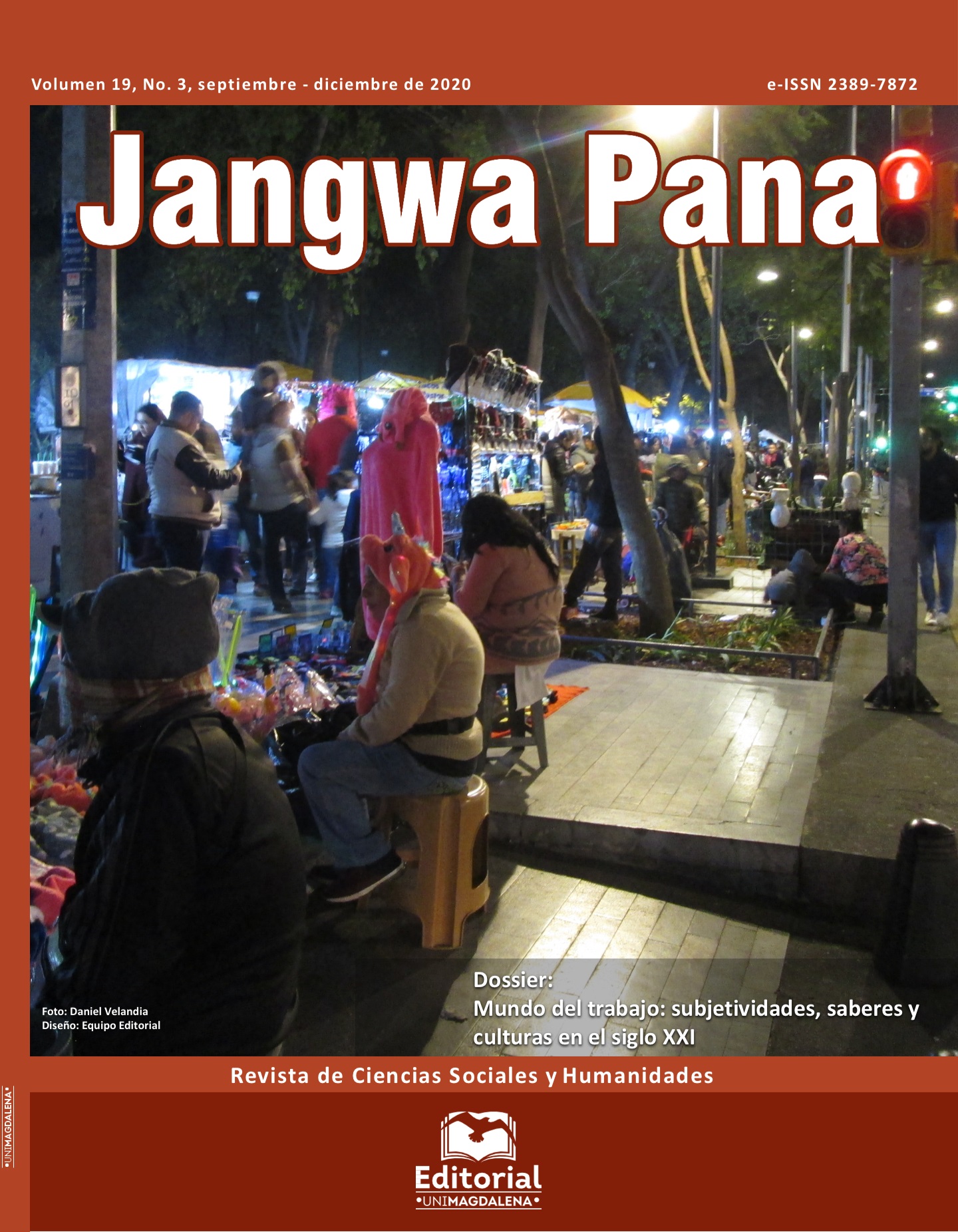Marks, points and lines in the Colombian Caribbean Sea
Main Article Content
Abstract
This article explains how the traditional fishermen of Old Providence, La Boquilla and Taganga, use “empirical knowledge” to create marks or points to navigate and fish in the Colombian Caribbean Sea without using GPS. The pilot of the boat, with “common sense” and ancestral experience, creates a mental navigation route to go fishing. This navigation map has reference marks or fixed points on the beach used as coordinates which unite in the moving plane that is the Caribbean Sea, allowing for travel. The ethnographic methodology, from interviews, context and information collected, demonstrates the process of extracting the image from the mind of the fisherman to make it visible to the fishermen as well as to the community. These analyzed and recreated images, verified through photo-elicitation, allow the mental drawings of the fishermen to be seen and are then transferred to a digital platform. In conclusion: the experience of revealing the mental maps of artisanal fishermen, through drawings in ink and graphite on paper, then transferred to a digital platform, offers a new look at navigation charts and oral stories of fishermen, visualized in a digital sea.
Downloads
Download data is not yet available.
Article Details
How to Cite
Leotteau, F. E. . (2020). Marks, points and lines in the Colombian Caribbean Sea . Jangwa Pana, 19(3), 452–475. https://doi.org/10.21676/16574923.3652
Issue
Section
General Section
References
Bachelard, G. (2000). La poética del espacio. Buenos Aires, Argentina: Fondo de Cultura Económica.
Cantoni, R. C. (2010). relievecontemporaneo.com. Recuperado de https://relievecontemporaneo.com/agua/: www.relievecontemporaneo.com
Garay, J. A. (2005). Informe del Estado de los ambientes marinos y Costeros en Colombia . Santa Marta, Colombia: Litoflash.
García Vargas, O. H. (2007). La cultura humana y su interpretación. Pensamiento & Gestión, 22. Universidad del Norte, 143-167.
Giannetti, C. (23 de Octubre de 2018). www.mediaartnet.org. Recuperado de http://www.mediaartnet.org/themes/aesthetics_of_the_digital/endo-aesthetics/6/: http://www.artmetamedia.net/
Gómez Alzate, A. (2018). El Pluralismo Cultural Expuesto en el Contexto Académico a partir del Diseño de una Estrategia de Comunicación. Memorias del 17 Festival Internacional de la Imagen (pp. 429-433). Manizales, Colombia: Universidad de Caldas.
Hemingway, E. (1989). El viejo y el mar. Recuperado de https://books.google.com/books?id=5-lsDwAAQBAJ&printsec=frontcover&dq=el+viejo+y+el+mar&hl=es-419&sa=X&ved=0ahUKEwio-9S7t5niAhVJu54KHdUVA-AQ6AEILjAB#v=onepage&q=el%20viejo%20y%20el%20mar&f=false
Hernández Carcía, I. C. (2005). Estética, Ciencias y Tecnologías. Creaciones electrónicas y numéricas. Bogotá D.C., Colombia: Pontificia Universidad Javeriana.
Leotteau, F. (2011). El Arte del Caribe colombiano en los XI y XII Salones Regionales de Artes (Tesis de maestría). Universidad Nacional de Colombia, San Andrés Islas, Colombia.
Leotteau, F. (2018). Mapas Mentales de pescadores artesanales en el Caribe colombiano (Tesis de doctorado). Universidad de Caldas, Manizales, Colombia.
Miami, U. O. (2018). Antillean Visions: Maps and The Making of The Caribbean. Miami, United States: NuPress of Miami, Inc.
OIT, Oficina Internacional del Trabajo Ginebra. (2013). https://www.ilo.org/global/publications/lang--es/index.htm. Recuperado el 6 de octubre de 2019, de OIT,: https://www.ilo.org/lima/paises/colombia/lang--es/index.htm
Pink, S. (2012). Doing Sensory Ethnographic. California, United States: SAGE.
RAE., D. d. (2014). Diccionario de la lengua española. Recuperado de https://dle.rae.es: dle.rae.es/señal
Varela, F. (2000). Four batons for the future of congnitive science, Envissioning Knowledge. Dumont Colonege: B. Wiens Ed.
Vives de Andrei, J. B. (22 de Diciembre de 1993). Instituto de Investigación Marinas y Costeras. Recuperado de https://www.ecured.cu/Instituto_de_Investigaciones_Marinas_y_Costeras_Jos%C3%A9_Benito_Vives_de_Andr%C3%A9is
Wartofsky, M. W. (2016). Estudio de la ciencia. Enciclopedia Gran Omeba. Tomo II. México: Editorial Bibiográfico Omeba. pp. 412-417.
Weisstein, E. W. (09 de octubre de 1995). Recuperado de www.mathworld.wolfram.com.
Zambrano, M. (1995). El hombre y lo divino. México: Fondo de Cultura Económica.
Cantoni, R. C. (2010). relievecontemporaneo.com. Recuperado de https://relievecontemporaneo.com/agua/: www.relievecontemporaneo.com
Garay, J. A. (2005). Informe del Estado de los ambientes marinos y Costeros en Colombia . Santa Marta, Colombia: Litoflash.
García Vargas, O. H. (2007). La cultura humana y su interpretación. Pensamiento & Gestión, 22. Universidad del Norte, 143-167.
Giannetti, C. (23 de Octubre de 2018). www.mediaartnet.org. Recuperado de http://www.mediaartnet.org/themes/aesthetics_of_the_digital/endo-aesthetics/6/: http://www.artmetamedia.net/
Gómez Alzate, A. (2018). El Pluralismo Cultural Expuesto en el Contexto Académico a partir del Diseño de una Estrategia de Comunicación. Memorias del 17 Festival Internacional de la Imagen (pp. 429-433). Manizales, Colombia: Universidad de Caldas.
Hemingway, E. (1989). El viejo y el mar. Recuperado de https://books.google.com/books?id=5-lsDwAAQBAJ&printsec=frontcover&dq=el+viejo+y+el+mar&hl=es-419&sa=X&ved=0ahUKEwio-9S7t5niAhVJu54KHdUVA-AQ6AEILjAB#v=onepage&q=el%20viejo%20y%20el%20mar&f=false
Hernández Carcía, I. C. (2005). Estética, Ciencias y Tecnologías. Creaciones electrónicas y numéricas. Bogotá D.C., Colombia: Pontificia Universidad Javeriana.
Leotteau, F. (2011). El Arte del Caribe colombiano en los XI y XII Salones Regionales de Artes (Tesis de maestría). Universidad Nacional de Colombia, San Andrés Islas, Colombia.
Leotteau, F. (2018). Mapas Mentales de pescadores artesanales en el Caribe colombiano (Tesis de doctorado). Universidad de Caldas, Manizales, Colombia.
Miami, U. O. (2018). Antillean Visions: Maps and The Making of The Caribbean. Miami, United States: NuPress of Miami, Inc.
OIT, Oficina Internacional del Trabajo Ginebra. (2013). https://www.ilo.org/global/publications/lang--es/index.htm. Recuperado el 6 de octubre de 2019, de OIT,: https://www.ilo.org/lima/paises/colombia/lang--es/index.htm
Pink, S. (2012). Doing Sensory Ethnographic. California, United States: SAGE.
RAE., D. d. (2014). Diccionario de la lengua española. Recuperado de https://dle.rae.es: dle.rae.es/señal
Varela, F. (2000). Four batons for the future of congnitive science, Envissioning Knowledge. Dumont Colonege: B. Wiens Ed.
Vives de Andrei, J. B. (22 de Diciembre de 1993). Instituto de Investigación Marinas y Costeras. Recuperado de https://www.ecured.cu/Instituto_de_Investigaciones_Marinas_y_Costeras_Jos%C3%A9_Benito_Vives_de_Andr%C3%A9is
Wartofsky, M. W. (2016). Estudio de la ciencia. Enciclopedia Gran Omeba. Tomo II. México: Editorial Bibiográfico Omeba. pp. 412-417.
Weisstein, E. W. (09 de octubre de 1995). Recuperado de www.mathworld.wolfram.com.
Zambrano, M. (1995). El hombre y lo divino. México: Fondo de Cultura Económica.

